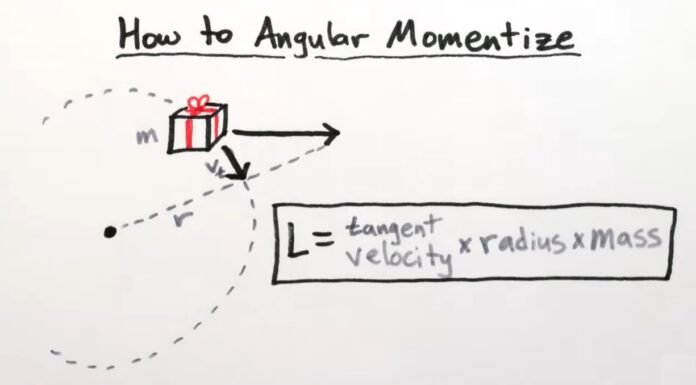Introduction
Angular momentum is a fundamental concept in physics that refers to the quantity of rotational motion of an object. It is the product of an object’s moment of inertia and its angular velocity. Angular momentum plays a crucial role in the description of many physical phenomena, such as the motion of planets, the behaviour of spinning tops, and the dynamics of atomic particles.
In this article, we will focus on angular momentum on a fixed axis, a type of angular momentum commonly used in classical mechanics.
Definition of Angular Momentum About Fixed Axis
Angular momentum is a fundamental concept in physics that refers to the quantity of rotational motion of an object. It is the product of an object’s moment of inertia and its angular velocity. Angular momentum plays a crucial role in the description of many physical phenomena, such as the motion of planets, the behaviour of spinning tops, and the dynamics of atomic particles.
Angular momentum about a fixed axis is a type of angular momentum that describes the rotational motion of an object around a fixed axis. The axis of rotation remains fixed in space, and the object rotates about this axis. This type of angular momentum is commonly used in classical mechanics to describe the motion of rotating objects, such as a spinning top or a gyroscope.
The formula for Angular Momentum About Fixed Axis
The unit of angular momentum:
The SI unit of angular momentum is kg m2/s or J s i.e. kilogram-meter squared per second (kg·m2/s).
The formula for angular momentum about a fixed axis :
The formula for angular momentum about a fixed axis is L = Iω
Where L is the angular momentum, I is the moment of inertia, and ω is the angular velocity.
The moment of inertia is a measure of an object’s resistance to rotational motion and is dependent on the object’s mass distribution and shape.
The angular velocity is the rate of change of the object’s angle with respect to time.
Conservation of Angular Momentum
One of the fundamental principles of physics is the conservation of angular momentum.
This principle states that the total angular momentum of a system remains constant if no external torque is applied to the system.
In other words, if the total angular momentum of a system is initially zero, it will remain zero throughout the motion.
This principle has many important applications, such as explaining the behaviour of planets in their orbits around the sun, the motion of spinning tops, and the dynamics of subatomic particles. The conservation of angular momentum is also used in many engineering applications, such as designing spacecraft and vehicles that need to maintain their stability during motion.
Conservation of angular momentum about a fixed axis states that if no external torque acts on a system about a fixed axis, the total angular momentum of the system remains constant.
Applications of Angular Momentum About Fixed Axis
Angular momentum about fixed axis has many practical applications in physics and engineering. Some of the most notable applications are:
Gyroscopes: Gyroscopes are devices that use angular momentum about a fixed axis to maintain their orientation and stability during motion. They are used in many applications, such as aircraft navigation, spacecraft control, and stabilizers for cameras and telescopes.
Rotating Machinery: Many types of rotating machinery, such as turbines, generators, and motors, use angular momentum about a fixed axis to convert mechanical energy into electrical or other forms of energy.
Planetary Motion: The motion of planets around the sun is governed by the conservation of angular momentum. This principle explains why the planets move in elliptical orbits and why their orbital velocities change as they move closer to or farther away from the sun.
Spinning Tops: Spinning tops are toys that use angular momentum about a fixed axis to maintain their motion and stability. They are used in many cultures for play and as educational tools.
Recommended Articles:
Angular Displacement: Introduction, Motion, and Formula
Angular Acceleration – Formula, Definition, Application, and Factors
The Angle of Incidence
Anemometer – Types and Practical Applications
Anatomy of Human Ear
Moment of inertia is the measure of an object's resistance to rotational motion about an axis. It is determined by the distribution of mass of an object and the distance of each mass element from the axis of rotation. Torque is the rate of change of angular momentum with respect to time. The greater the torque, the greater the rate of change of angular momentum, and vice versa. The moment of inertia determines the amount of angular momentum that an object has for a given angular velocity. An object with a larger moment of inertia will have a greater angular momentum for the same angular velocity compared to an object with a smaller moment of inertia. Linear momentum is the product of the mass and velocity of an object, while angular momentum is the product of the moment of inertia and angular velocity of an object around a fixed axis. Linear momentum is associated with linear motion, while angular momentum is associated with rotational motion. Some of the most notable applications are in gyroscopes used in aircraft navigation, spacecraft control, stabilizers for cameras and telescopes; rotating machinery like turbines, generators, and motors; planetary motion and spinning tops. Angular Momentum About Fixed Axis FAQs
What is the moment of inertia?
What is the relationship between torque and angular momentum?
How does the moment of inertia affect angular momentum?
What is the difference between linear momentum and angular momentum?
What are the main applications of Angular Momentum About Fixed Axis?
